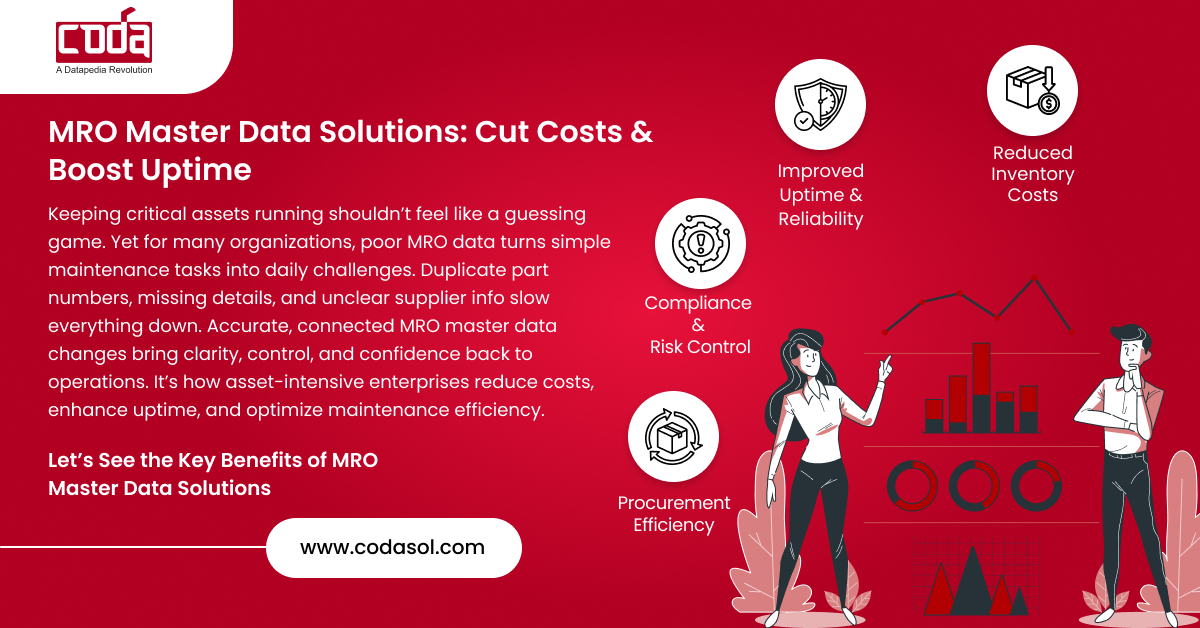How Asset‑Intensive Enterprises Cut Costs & Boost Uptime
If your spare parts are overstocked, downtime keeps creeping up, and your maintenance teams don’t trust the data in your ERP, you have an MRO problem. The real issue is not just processes or people; it’s the quality of your MRO master data. Without reliable, standardized data on spare parts, equipment, and suppliers, operations grind down, costs climb, and compliance becomes a nightmare. This article explains how MRO master data solutions, including platforms like Prosol, CODASOL’s flagship SaaS solution available in the SAP Store, deliver measurable ROI for asset‑intensive enterprises across Oil & Gas, Utilities, Manufacturing, Ports, and beyond.
Why Poor MRO Data Costs You Millions
MRO master data refers to the structured information about spare parts, materials, suppliers, and equipment required to keep assets running. When this data is inaccurate or duplicated:
- Duplicate parts inflate inventory and working capital.
- Incorrect descriptions delay procurement.
- Missing specifications cause stockouts during critical breakdowns.
- Poor visibility reduces negotiation leverage with suppliers.
For example, a GCC utility carrying 20% more inventory than required ties up millions of dollars in idle stock while still experiencing emergency shutdowns due to missing parts.
Key Benefits of MRO Master Data Solutions
For decision‑makers, MRO master data solutions are not IT projects, they are cost‑reduction and performance levers.
- Reduced Inventory Costs: Clean master data eliminates duplicates and enables optimal stocking levels.
- Improved Uptime & Reliability: Accurate parts data supports predictive maintenance and ensures critical spares are available.
- Compliance & Risk Control: Standardized data ensures alignment with safety regulations and reduces operational risks.
- Procurement Efficiency: Unified catalogs give procurement teams leverage with vendors and streamline sourcing.
What to Look for in an MRO Master Data Solution
When evaluating solutions, focus on the following:
- Data Quality Tools: Deduplication, enrichment, and taxonomy standardization.
- Governance Model: Clear ownership across Maintenance, Procurement, and IT.
- Integration: Seamless with ERP, EAM, CMMS, and procurement systems.
- Domain Expertise: Ability to handle complex MRO taxonomies across industries.
- Scalability: Support for multi‑plant, multi‑geography operations.
- Analytics & Reporting: Dashboards showing KPIs like spare parts turnover, downtime costs, and inventory value.
Implementation Roadmap: 5 Steps to Success
- Audit Current Data – Identify duplicates, inconsistencies, and missing fields.
- Cleanse & Standardize – Build a master item catalog with harmonized taxonomy and unique identifiers.
- Define Governance – Assign data ownership, approval workflows, and quality monitoring processes.
- Integrate Systems – Sync master data across ERP, CMMS, and EAM platforms.
- Continuous Improvement – Monitor KPIs and refresh data periodically to prevent “data decay.”

Unlock savings hidden in your MRO data with Prosol, CODASOL’s SaaS platform available in the SAP Store.
Case Study
A leading petrochemical company in the Middle East implemented a comprehensive MRO master data project across five plants. Results within 12 months:
- 20% reduction in inventory value, releasing over $15M in working capital.
- 15% drop in unplanned downtime, improving asset availability.
- Procurement savings of 8% through consolidated vendor negotiations.
MRO Master Data Solution Approaches
| Approach | Pros | Cons | Best Fit |
|---|---|---|---|
| In‑house Cleanup | Low cost, control stays internal | Resource‑intensive, limited expertise | Small, single‑site firms |
| Consulting‑led Projects | Expert guidance, fast turnaround | Higher upfront cost | Large enterprises with legacy issues |
| SaaS MDM Platforms | Scalable, integrated, AI/ML‑driven cleansing | Subscription fees, change management | Multi‑plant, asset‑intensive firms |
Risks & Challenges to Address
- Silos & Ownership Conflicts: Procurement, Maintenance, and IT often disagree on data governance.
- Legacy Data Complexity: Old systems with inconsistent formats make cleansing difficult.
- Cultural Resistance: Teams underestimate the business value of clean data.
- Ongoing Maintenance: Data degrades quickly if not actively monitored.
MRO Master Data Checklist
Before investing in an MRO master data solution, ensure the provider can:
- Deliver proven data cleansing and enrichment capabilities.
- Integrate with existing ERP, CMMS, and procurement systems.
- Provide governance frameworks tailored to your industry.
- Demonstrate ROI through case studies or projections.
- Offer long‑term data maintenance and support.
- Showcase credibility with marketplace presence (e.g., Prosol in the SAP Store).
Conclusion
Clean, reliable MRO master data transforms maintenance and operations from reactive firefighting into strategic value creation. By standardizing, cleansing, and governing spare parts and asset data, organizations reduce costs, boost uptime, and unlock long‑term operational resilience.
Ready to see the ROI of clean MRO data in your enterprise?

Frequently Asked Questions
1. What is master data in the context of MRO?
It is structured information about spare parts, equipment, suppliers, and materials required for maintenance and repair activities.
2. How long does implementing an MRO master data solution take?
Typically 3–12 months, depending on data complexity, number of sites, and system integration needs.
3. Who should own MRO master data in an organization?
Governance should be shared across Procurement, Maintenance, and IT, with a central data stewardship role.
4. What ROI can enterprises expect?
Savings range from 10–20% in inventory value, 5–15% reduction in downtime, and improved procurement leverage.
5. How do you keep MRO master data accurate over time?
By assigning ownership, setting update workflows, and monitoring KPIs to prevent data decay.

